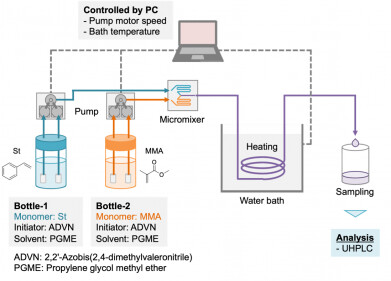Research News
Optimised delivery system offers precision target capability
Jun 19 2024
Researchers from the University of Utah have optimised an emerging method of drug delivery whereby nanodroplet carriers release the drug when triggered by a focused beam of ultrasound. The new protocol was said to both safe and efficient, delivering the drug to exactly the spot required and which they hoped would pave the way for first in-human trials.
“Here we show a method to deliver drugs to specific areas of the body where they are needed. We do so using ultrasound waves, which trigger drug release from circulating nanocarriers when focused on the target,” said Matthew G Wilson, a graduate research assistant at the University of Utah, and the study’s first author.
“We developed a method to produce stable nanocarriers repeatably and identified ultrasound parameters that can activate them.”
The nanocarriers are minuscule droplets, between 470 and 550 nanometers across, with a hollow outer shell composed of polymer molecules. These polymers have two distinct ends: a ‘hydrophilic’ one, which mixes well with watery solutions like blood and which faces outward, and a ‘hydrophobic’ one that doesn’t mix with water and which faces inwards.
Within the shell is an inner core of hydrophobic perfluorocarbons, molecules that consist mostly of fluorine and carbon and which are mixed with an equally hydrophobic drug of interest. The shells keep the cores apart, preventing them from coalescing into a single droplet and form a barrier against the immune system. The effect is much like mayonnaise, where proteins from eggs form droplets of encapsulated oils, where otherwise the oil and water would separate completely.
To release the drug, the researchers played back an ultrasound – a sound wave with a frequency beyond the upper limit of human hearing – of 300 or 900 kilohertz. The beam of ultrasound can be steered across three dimensions, to focus on a targted area within the body that is only a few millimeters across.
The ultrasound is thought to cause the perfluorocarbons to expand, stretching out the droplet’s shell and making it more permeable to the drug, which then diffuses out to the organs, tissues, or cells where it is required.
The researchers compared the efficiency of delivery of a representative drug – the anesthetic and sedative propofol – between three different perfluorocarbons, perfluoropentane (PFP), decafluoropentane (DFP), and perfluorooctylbromide (PFOB). The ultrasound was delivered to the nanodroplets in vitro, in 60 pulses of 100 milliseconds over one minute.
The results showed that the balance between stability of the nanodroplets and the efficiency of delivery was optimal for PFOB cores.
“Previous studies have focused on perfluorocarbons with low boiling points – usually lower than the human body temperature. We found that droplets with a PFOB core, which has a boiling point of 142 °C, are much more stable over time,” explained Wilson.
“Despite its high boiling point, PFOB can achieve similar levels of drug release when low-frequency ultrasound of 300 kilohertz is applied. The ultrasound frequency turned out to be a critical factor in our study.”
A test for safety showed that the nanodroplets were well tolerated, with no detectable side-effects. These experiments will need to be replicated in microdosing or Phase I trials on human volunteers.
The authors also published their protocol for the production of the nanodroplets as open science, so other research groups can learn directly from their findings.
“The method we developed can be applied to any of a variety of conditions depending on the drug used. For psychiatric applications, localized delivery of propofol could be used as a diagnostic tool to identify brain regions causally involved in disorders for individual patients. For more lasting treatment, ketamine delivery could be a potent method to rewire neural circuits,” concluded Wilson’s academic supervisor, Dr Jan Kubanek, an assistant professor at the University of Utah, and the study’s senior author.
“Targeted drug release from stable and safe ultrasound-sensitive nanocarriers” was published in Frontiers in Molecular Biosciences
More information online
Digital Edition
Lab Asia 31.6 Dec 2024
December 2024
Chromatography Articles - Sustainable chromatography: Embracing software for greener methods Mass Spectrometry & Spectroscopy Articles - Solving industry challenges for phosphorus containi...
View all digital editions
Events
Jan 22 2025 Tokyo, Japan
Jan 22 2025 Birmingham, UK
Jan 25 2025 San Diego, CA, USA
Jan 27 2025 Dubai, UAE
Jan 29 2025 Tokyo, Japan



















